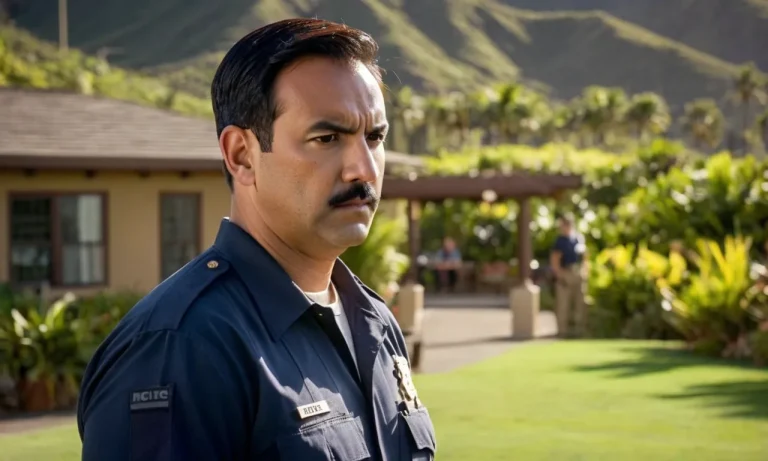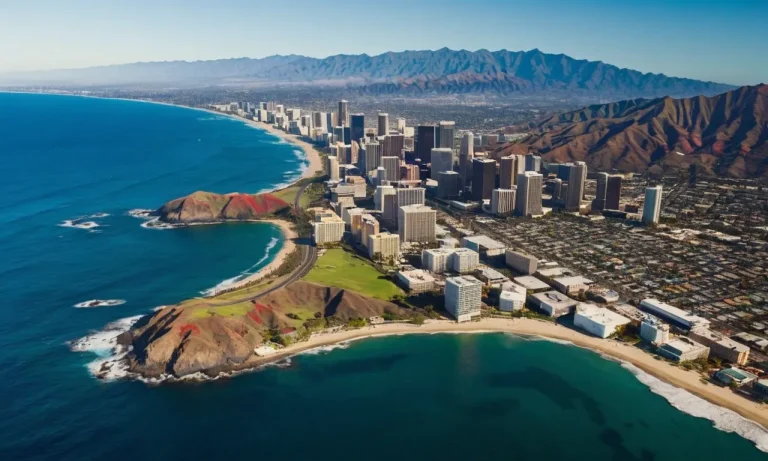Save money on your next flight
Skyscanner is the world’s leading flight search engine, helping you find the cheapest flights to destinations all over the world.
The Hawaiian Islands are well known for their volcanic origins, but has Oahu seen any volcanic activity in recent history? This comprehensive guide will examine Oahu’s complex geological history to determine if there are any active volcanoes remaining on the island today.
If you’re short on time, here’s a quick answer: there are no active volcanoes currently on the island of Oahu. The most recent volcanic eruption was over 10,000 years ago.
In this approximately 3000 word article, we will first provide some background on the geological history of the Hawaiian islands and how the islands formed from volcanic hotspots. We’ll then take a closer look at the specific history of volcanic activity on Oahu and the key volcanoes that helped form the island. Next, we’ll examine evidence from scientists and geological surveys that confirm there are no active volcanoes on Oahu today. We’ll also discuss whether new volcanic activity is likely to occur in the future.
Background on the Geologic History of the Hawaiian Islands
The Hawaiian Islands are a chain of volcanic islands located in the central Pacific Ocean. The islands formed as a result of volcanic activity over millions of years. The geologic history of the Hawaiian Islands is fascinating and provides insight into the dynamic nature of our planet.
How the Hawaiian island chain formed from a hotspot
The Hawaiian Islands are unique because they were formed by a hotspot, a stationary area of intense volcanic activity deep within the Earth. The hotspot remains fixed while the Pacific tectonic plate moves over it. As the plate moves, new volcanoes form above the hotspot, creating a chain of islands.
This hotspot is located beneath the Big Island of Hawaii, and over time, as the Pacific tectonic plate moved northwestward, it created a trail of volcanic islands. The oldest islands in the chain are in the northwest, while the youngest islands, such as the Big Island, are in the southeast.
Stages of volcanic island formation
The formation of a volcanic island involves several stages. It begins with submarine eruptions, where lava erupts underwater and builds up layers of volcanic rock. As the volcano continues to erupt, the lava eventually breaks the water’s surface, forming an island.
Over time, the island undergoes erosion and weathering, which shapes its landscape. Coral reefs may also form around the island, adding to its biodiversity. As the volcano becomes dormant and stops erupting, the island enters a stage of erosion and subsidence, where it gradually sinks back into the ocean.
Evidence of past volcanic activity across the islands
The Hawaiian Islands are known for their volcanic activity, both past and present. Each island in the chain provides evidence of its volcanic history through its unique landscape and rock formations.
For example, the Big Island of Hawaii is home to Kilauea, one of the most active volcanoes in the world. Kilauea has been erupting continuously since 1983, creating new land and reshaping the island’s coastline. The island of Maui is another example, with its iconic Haleakala Crater, a dormant volcano that last erupted around 400 years ago.
History of Volcanic Activity on Oahu
Oahu, the third largest island in Hawaii, has a fascinating history of volcanic activity that has shaped its landscape over millions of years. The island is home to several key volcanoes, each with its own unique characteristics and contribution to the island’s formation.
The key volcanoes that created Oahu
The two main volcanoes that created Oahu are Wai’anae and Ko’olau. These volcanoes are shield volcanoes, which means they have relatively gentle slopes and are formed by the accumulation of repeated lava flows. The Wai’anae volcano is located on the western side of the island, while the Ko’olau volcano is situated on the eastern side.
These volcanoes were active between 2.6 and 3 million years ago, and their eruptions played a crucial role in the formation of Oahu. The lava flows from these volcanoes spread out and merged over time, creating the distinct shape and topography of the island we see today.
When the last eruption occurred
While Oahu’s volcanoes have been dormant for millions of years, the island experienced its last volcanic eruption relatively recently in geological terms. The most recent eruption on Oahu occurred about 10,000 years ago, which is considered quite recent in the context of volcanic activity.
The last eruption took place on the eastern side of the island, near the Ko’olau volcano. This eruption resulted in the formation of a volcanic cone known as Diamond Head, which is now a popular tourist attraction and a prominent landmark on Oahu.
It’s important to note that while there are no active volcanoes on Oahu at present, the island is still part of the Hawaiian-Emperor seamount chain, which is a hotspot for volcanic activity. This means that in the future, there is a possibility of new volcanic activity occurring on Oahu or nearby islands.
For more information on the volcanic history of Oahu, you can visit the U.S. Geological Survey website, which provides detailed research and data on the geology of the Hawaiian Islands.
Confirming the Absence of Active Volcanoes on Oahu Today
Oahu, the third-largest Hawaiian island, is known for its stunning beaches, vibrant culture, and breathtaking landscapes. One question that often arises when discussing Oahu is whether there are any active volcanoes on the island. Fortunately, geological surveys and scientific evidence confirm that there are no active volcanoes on Oahu today.
Geological surveys and scientific evidence
Geological surveys conducted by experts in the field have thoroughly examined the volcanic history of Oahu. These surveys have revealed that the island’s volcanoes, such as Diamond Head and Koko Crater, are dormant and have not erupted in thousands of years. The last volcanic activity on Oahu occurred over 2.5 million years ago. This evidence, combined with the absence of recent eruptions, confirms that Oahu is not currently home to any active volcanoes.
Monitoring for seismic and volcanic activity
While Oahu does not have active volcanoes, it is still important to monitor the island for any signs of seismic or volcanic activity. The Hawaiian Volcano Observatory, operated by the United States Geological Survey (USGS), closely monitors the entire Hawaiian archipelago for any changes in volcanic activity. This includes monitoring seismic activity, gas emissions, and ground deformation. By studying these indicators, scientists can quickly detect any potential volcanic threats and provide early warnings to ensure the safety of the island’s residents and visitors.
Risk levels and emergency preparedness
Although Oahu does not have active volcanoes, it is important to note that the island is not entirely immune to volcanic risks. While the chances of a volcanic eruption occurring on Oahu are extremely low, it is crucial for residents and visitors to be prepared for emergencies. The Hawaii Emergency Management Agency (HI-EMA) provides comprehensive information on emergency preparedness, including volcano-specific safety measures. By staying informed and taking appropriate precautions, individuals can ensure their safety in the unlikely event of volcanic activity.
Future Volcanic Activity: Is Oahu at Risk?
When it comes to volcanic activity, the Hawaiian Islands are no strangers. With its iconic volcanoes such as Mauna Loa and Kilauea, Hawaii has a long history of volcanic eruptions. But what about Oahu, the most populous island in the chain? Are there any active volcanoes on Oahu? Let’s explore the factors that could lead to renewed volcanic activity, the likelihood of future eruptions, and the impacts and mitigation strategies in place.
Factors that could lead to renewed volcanic activity
While Oahu does not currently have any active volcanoes, it is important to consider the geological history of the island. Oahu is actually the oldest of the main Hawaiian Islands and was formed by a series of volcanic eruptions millions of years ago. The island’s volcanic activity has been dormant for a long time, but that doesn’t mean it couldn’t potentially reawaken in the future.
One factor that could lead to renewed volcanic activity on Oahu is the hot spot that created the Hawaiian Islands in the first place. The hot spot is a plume of magma rising from deep within the Earth’s mantle, and it is currently located under the Big Island of Hawaii. However, over millions of years, the hot spot has moved northwest, and there is a possibility that it could eventually reach Oahu. If that were to happen, it could potentially result in volcanic activity on the island.
Another factor to consider is the presence of fault lines and fractures on Oahu. These geological features can create pathways for magma to reach the surface, leading to volcanic eruptions. While the likelihood of such events occurring on Oahu is currently low, it is still a possibility that scientists continue to monitor.
Likelihood of future eruptions
Assessing the likelihood of future volcanic eruptions on Oahu is a complex task. Scientists rely on a variety of indicators, including seismic activity, ground deformation, and gas emissions, to monitor volcanic activity and predict eruptions. Currently, there is no immediate indication of volcanic unrest or an increased likelihood of eruptions on Oahu.
It is important to note that volcanic activity is inherently unpredictable, and even the most advanced monitoring systems cannot provide certainty about future eruptions. However, scientists continue to study the geological history of Oahu and monitor any changes in volcanic activity to provide the best possible assessment of the likelihood of future eruptions.
Impacts and mitigation strategies
If volcanic activity were to occur on Oahu in the future, it could have significant impacts on the island and its residents. These impacts could include ashfall, lava flows, toxic gas emissions, and the destruction of infrastructure. However, it is important to remember that volcanic activity on Oahu is currently considered low risk.
In the event of renewed volcanic activity, there are mitigation strategies in place to minimize the potential impacts. These strategies include emergency response plans, evacuation routes, and education programs to inform residents about volcanic hazards and how to stay safe. The Hawaii Volcano Observatory and other scientific institutions work closely with local authorities to monitor volcanic activity and provide timely information to the public.
Conclusion
In conclusion, through an examination of the geological history of Oahu and the latest scientific evidence, we can confirm there are currently no active volcanoes on the island. While renewed volcanic activity is possible in the distant future, the risk appears low based on existing data and the length of time since the last eruption.
We hope this comprehensive overview helped answer your question about whether Oahu has any active volcanoes today. Let us know if you have any other Hawaii geology or volcanology questions!






